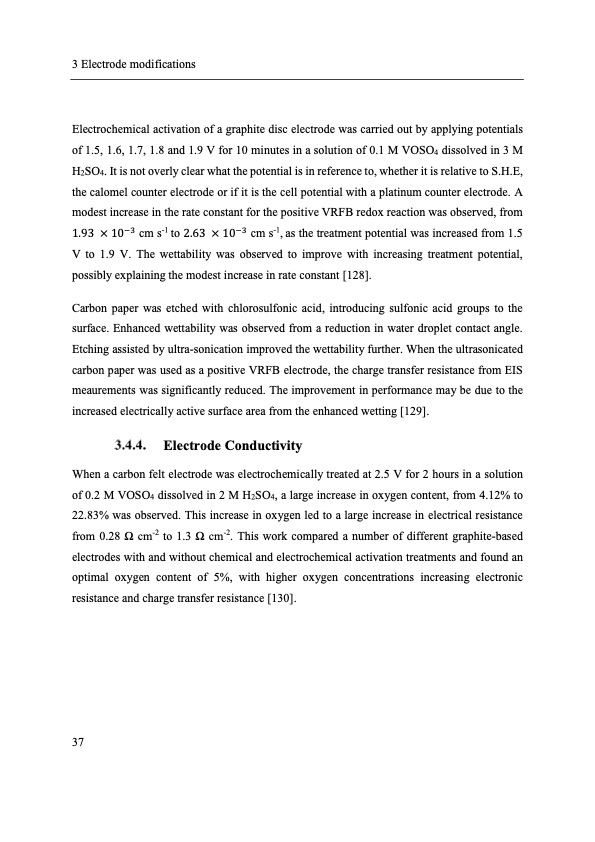
PDF Publication Title:
Text from PDF Page: 049
3 Electrode modifications Electrochemical activation of a graphite disc electrode was carried out by applying potentials of 1.5, 1.6, 1.7, 1.8 and 1.9 V for 10 minutes in a solution of 0.1 M VOSO4 dissolved in 3 M H2SO4. It is not overly clear what the potential is in reference to, whether it is relative to S.H.E, the calomel counter electrode or if it is the cell potential with a platinum counter electrode. A modest increase in the rate constant for the positive VRFB redox reaction was observed, from 1.93 × 10−3 cm s-1 to 2.63 × 10−3 cm s-1, as the treatment potential was increased from 1.5 V to 1.9 V. The wettability was observed to improve with increasing treatment potential, possibly explaining the modest increase in rate constant [128]. Carbon paper was etched with chlorosulfonic acid, introducing sulfonic acid groups to the surface. Enhanced wettability was observed from a reduction in water droplet contact angle. Etching assisted by ultra-sonication improved the wettability further. When the ultrasonicated carbon paper was used as a positive VRFB electrode, the charge transfer resistance from EIS meaurements was significantly reduced. The improvement in performance may be due to the increased electrically active surface area from the enhanced wetting [129]. Electrode Conductivity When a carbon felt electrode was electrochemically treated at 2.5 V for 2 hours in a solution of 0.2 M VOSO4 dissolved in 2 M H2SO4, a large increase in oxygen content, from 4.12% to 22.83% was observed. This increase in oxygen led to a large increase in electrical resistance from 0.28 Ω cm-2 to 1.3 Ω cm-2. This work compared a number of different graphite-based electrodes with and without chemical and electrochemical activation treatments and found an optimal oxygen content of 5%, with higher oxygen concentrations increasing electronic resistance and charge transfer resistance [130]. 37PDF Image | Electron Transfer Kinetics in Redox Flow Batteries

PDF Search Title:
Electron Transfer Kinetics in Redox Flow BatteriesOriginal File Name Searched:
electron-transfer-flow-batteries-thesis.pdfDIY PDF Search: Google It | Yahoo | Bing
Salgenx Redox Flow Battery Technology: Salt water flow battery technology with low cost and great energy density that can be used for power storage and thermal storage. Let us de-risk your production using our license. Our aqueous flow battery is less cost than Tesla Megapack and available faster. Redox flow battery. No membrane needed like with Vanadium, or Bromine. Salgenx flow battery
| CONTACT TEL: 608-238-6001 Email: greg@salgenx.com | RSS | AMP |